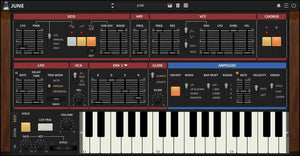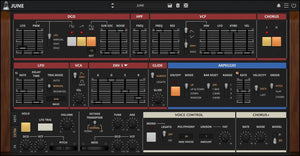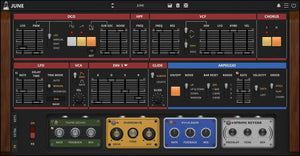Your Cart is Empty



AudioThing JUNE
Classic Analog Polysynth
TEST4b
$69.00$39.00Rated 5.0 out of 5 stars
4 Reviews
Description
JUNE is a faithful emulation of the Roland JUNO-60, one of the most iconic polyphonic analog synthesizers from the early 1980s.
We spent months living with the original, studying every quirk and charm, from the warm, steady DCO to the silky filter and that unmistakable chorus, then modeled its circuits in detail to bring its soul into software.
Do we really need another JUNO?
We think the answer is yes, if it’s done with care.
JUNE isn’t just another look-alike. We spent a long time with the real thing, studying every circuit and chasing the tiny details that make it feel alive: the way the DCO behaves, how the envelopes respond, how the filter breathes, and how the chorus shimmers and dances around the sound.
We wanted to capture that exact feeling but also make it practical for modern production.
The Roland JUNO-60 was released in 1982 as the successor to the JUNO-6, adding patch memory and a DCB interface while keeping the same core sound architecture. It offered six voices, each with a DCO and suboscillator, a resonant low pass filter, a non-resonant high pass filter, and the now iconic stereo chorus. Known for lush pads, chorused strings, and rhythmic arpeggiated patterns, the JUNO-60 was used by artists such as The Cure, Eurythmics, Enya, and Animal Collective, among many others.
Arpeggio
The JUNO-60’s arpeggiator is one of those simple features that ends up sparking whole ideas. Nils Frahm and others have relied on it for hypnotic, evolving patterns that work especially well with external effects. In JUNE, we carefully recreated that original feel and added a few thoughtful updates: new play modes, an adjustable range of up to four octaves, bar reset, and extra control over rate, velocity, and note order. It keeps the instant, hands-on vibe of the classic, while giving you more room to shape and perform your own patterns.
VCF
The filter is a big part of what makes a JUNO feel alive. A 24 dB low pass with a gentle high pass in front, built around the classic IR3109 VCF chip.
It’s smooth and warm when you open it up, but it can bite when you add resonance.
We spent time making sure it moves and breathes like the real thing: soft when you need it, bright when you push it, so it always feels musical under your fingers.
BBD Chorus
Like other Roland synthesizers of the early 1980s, the JUNO-60 includes a BBD-based stereo chorus that gives it much of its character. In JUNE, the chorus circuit has been modelled in detail, including the MN3009 BBD chips with 256 stages each, the surrounding filters, and the LFOs that drive modes I, II, and I+II. A rate multiplier allows adjustment of the internal LFO speed, with the option to switch to the slightly different JUNO-6 values. The JUNO-60 chorus also has a different texture compared to RES-09, our emulation of the Roland RS-09.
JUNE includes a set of four high-quality effects, inspired by classic gear and designed to complement the synth’s character.
The effects section features:
- Tape Echo, based on our Space Echo emulation Outer Space
- Spring Reverb, adding classic vintage reverb
- Overdrive, for rich harmonic distortion inspired by classic guitar pedals
- Phaser, delivering deep, swirling modulation inspired by vintage analog phase shifters
- You can rearrange the effects in any order using drag and drop.
Tech Specs
macOS
- Requires macOS 10.13 or higher
- AU, VST2, VST3, AAX, CLAP, Standalone
- (64bit only)
Windows
- Requires Windows 7 or higher
- VST2, VST3, AAX, CLAP, Standalone
- (64bit only)
Linux
- Requires Ubuntu 20.04 or newer
- VST2, VST3, CLAP, Standalone
- (64bit only)






